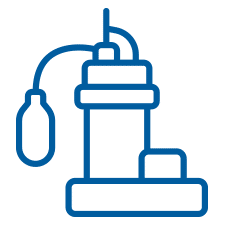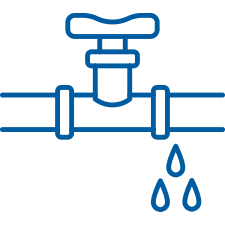Efflorescence
Efflorescence is a common problem that signals water intrusion and porous concrete in your basement.
What is Efflorescence?
Efflorescence is a white, powdery residue that forms on surfaces such as concrete, brick, stone, or masonry. It occurs when water-soluble salts in the building materials or ground are dissolved by water and brought to the surface. When the water evaporates, the salts are left behind, resulting in visible crystalline deposits of efflorescence.
Key characteristics of efflorescence are:
- Appearance: Efflorescence appears as a white or grayish-white powdery substance on the surface of materials. It may take the form of fluffy crystals, crusty deposits, or stains.
- Soluble salts: The primary components of efflorescence are usually salts such as calcium carbonate, calcium sulfate, or sodium chloride. These salts are often naturally present in building materials or in the soil surrounding the materials.
- Occurrence: Efflorescence typically occurs in areas where moisture is present, such as basements, crawl spaces, exterior walls, or areas exposed to water leaks or high humidity.
What Causes Efflorescence?
The presence of water-soluble salts and moisture in building materials causes efflorescence. Efflorescence itself doesn’t cause structural damage, but it proves that moisture is entering the materials, which can contribute to degradation over time. It is important to address the underlying moisture source and take appropriate measures to prevent further water intrusion and protect the integrity of the building materials. Here are the key factors that contribute to the occurrence of efflorescence:
- Water infiltration: Water from various sources, such as rain, groundwater, or leaks, can penetrate building materials. As the water moves through the materials, it dissolves the salts present in them.
- Soluble salts: Building materials, including concrete, brick, stone, or mortar, may naturally contain soluble salts. These salts can come from the materials themselves, as well as from the surrounding soil or water.
- Capillary action: Capillary action is the movement of water through porous materials. When moisture enters the building materials, it carries dissolved salts with it as it moves toward the surface through capillary action.
- Evaporation: As the water reaches the surface, it evaporates, leaving behind the dissolved salts. The salts crystallize and form the visible white or grayish-white powdery deposits of efflorescence.
Several factors can contribute to the intensity and frequency of efflorescence:
- Climate and weather conditions
- Poor drainage
- Construction materials and techniques
- Curing process
What are the Signs of Efflorescence?
The signs of efflorescence are generally visible on the surface of materials such as concrete, brick, stone, or masonry. Efflorescence itself is a symptom of moisture-related issues and not a problem on its own. It signals that there is water infiltration or excessive moisture within the materials. If you notice efflorescence, you should try to identify and address the underlying cause of the moisture. This could be due to leaks, poor drainage, or improper sealing. By addressing the moisture source, you can prevent further efflorescence and potential damage to the building materials. Here are the common signs to look for:
- White or grayish-white deposits
- Crusty or fluffy texture
- Staining
- Discoloration of grout or mortar
- Seasonal variations
- Absence of water leak
How Do I Fix Efflorescence?
It’s important to address the underlying moisture issue and remove the existing deposits to fix efflorescence. This may involve fixing leaks, improving drainage systems, sealing cracks or gaps in the structure, or addressing ventilation and humidity control issues. Efflorescence can be physically removed from surfaces using appropriate cleaning methods and solutions. However, if efflorescence persists or is accompanied by other water-related problems, you should contact a professional at Perma-Seal to assess the situation and recommend solutions for moisture control and prevention.
Contact Us for Water Intrusion Solutions In Chicago and NW Indiana
Our team at Perma-Seal offers professional waterproofing services using our various solutions designed for your home or business. Contact our experts today by calling 800-421-7325 or click the button below to fill out our online contact form.







